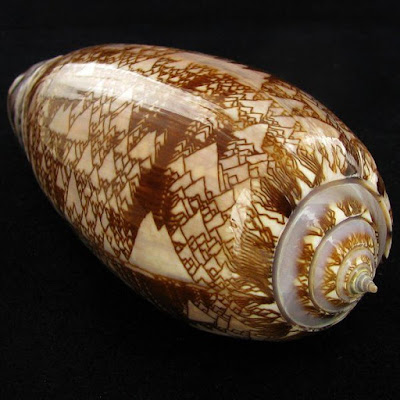
Came across this interesting specimen. Its pattern is otherwordly, almost too euclidic. The motive resembles the Sierpinski triangle.

One of the most important mathematical models in developmental biology has been that formulated by Alan Turing (1952), one of the founders of computer science (and the mathematician who cracked the German “Enigma” code during World War II). He proposed a model wherein two homogeneously distributed solutions would interact to produce stable patterns during morphogenesis. These patterns would represent regional differences in the concentrations of the two substances. Their interactions would produce an ordered structure out of random chaos. !!
Turing's reaction-diffusion model involves two substances. One of them, substance S, inhibits the production of the other, substance P. Substance P promotes the production of more substance P as well as more substance S. Turing's mathematics show that if S diffuses more readily than P, sharp waves of concentration differences will be generated for substance P (Figure 1.20). These waves have been observed in certain chemical reactions (Prigogine and Nicolis 1967; Winfree 1974).

Figure 1.20
Reaction-diffusion (Turing model) system of pattern generation. Generation of periodic spatial heterogeneity can come about spontaneously when two reactants, S and P, are mixed together under the conditions that S inhibits P, P catalyzes production of (more...)
The reaction-diffusion model predicts alternating areas of high and low concentrations of some substance. When the concentration of such a substance is above a certain threshold level, a cell (or group of cells) may be instructed to differentiate in a certain way. An important feature of Turing's model is that particular chemical wavelengths will be amplified while all others will be suppressed. As local concentrations of P increase, the values of S form a peak centering on the P peak, but becoming broader and shallower because of S's more rapid diffusion. These S peaks inhibit other P peaks from forming. But which of the many P peaks will survive? That depends on the size and shape of the tissues in which the oscillating reaction is occurring. (This pattern is analogous to the harmonics of vibrating strings, as in a guitar. Only certain resonance vibrations are permitted, based on the boundaries of the string.)
The mathematics describing which particular wavelengths are selected consist of complex polynomial equations. Such functions have been used to model the spiral patterning of slime molds, the polar organization of the limb, and the pigment patterns of mammals, fish, and snails (Figures 1.21 and 1.22; Kondo and Asai 1995; Meinhardt 1998). A computer simulation based on a Turing reaction-diffusion system can successfully predict such patterns, given the starting shapes and sizes of the elements involved.
https://www.ncbi.nlm.nih.gov/books/NBK10126/



Keine Kommentare:
Kommentar veröffentlichen